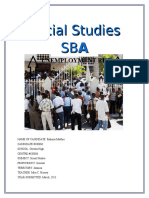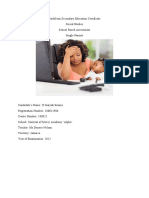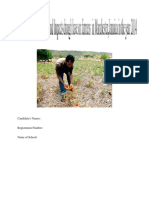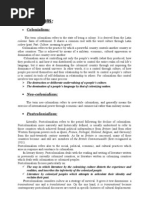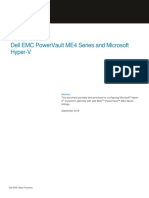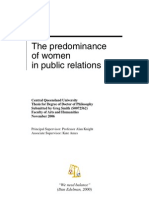THE SBA-Social Studies
THE SBA-Social Studies
Uploaded by
Amanda BernardCopyright:
Available Formats
THE SBA-Social Studies
THE SBA-Social Studies
Uploaded by
Amanda BernardCopyright
Available Formats
Share this document
Did you find this document useful?
Is this content inappropriate?
Copyright:
Available Formats
THE SBA-Social Studies
THE SBA-Social Studies
Uploaded by
Amanda BernardCopyright:
Available Formats
Topic: An investigation as to how technology impacts on families in the community of Good Hope Westmoreland
Name: Loushana Campbell Teacher: Mr. Smith Institution: Supreme Educational Institute
PG
Acknowledgement .1 Section 1 Introduction............2 Statement of the Problem......3 Section 2 Method of Investigation....4 Instruments used to Collect Data5-9 Procedures used to Collect Data..10 Section 3 Graphical Representation of Data11-15 Interpretation of Data.......16-17 Section 4 Findings..18 Recommendations..19
The Good Hope Community is located in the Negril, Westmoreland Jamaica. The Good Hope community consists of approximately 300 households ranging from low income to high income families. I have been residing in the Good Hope community for the past ten (10) years. During this tenure, I became concerned as I observed how families used technological devices and I realized that while technology has been playing an integral role in every aspects of our lives, it also created problems or have a negative impact on families. Technology has been defined as the extension of our human capacity in order to satisfy our needs or wants. Technological devices can be defined as those devices that are designed to be used by humans to make life easy and or for pleasure. Some of these includes and are not limited to cellphones, computers, satellite TV, washing machines, microwaves etc. these devices have a multitude of functions ranging from the ability to heat frozen foods to the capability of transferring messages by just a click of a button. Take the cellphone for example, this device provides an affordable way ro communicate with family and friends across borders; provides the user with the ability to store information such as contacts etc. As a result, I have decided to conduct a research to determine the effects technology on the families in the community of Good hope, Negril.
Statement of the Problem
How technology impacts on the families in the community of Good Hope, Westmoreland?
Reason for Research
The reason for this research is to disclose the effects that technology have on the families in Good Hope. The Researcher realized that the overuse of technology has negatively affected the personal and professional lives of residents in the Good Hope Community. Also, the Researcher recognizes several issues with how families in the Good Hope Community uses technology and therefore, seeks to provide recommendations as to how these issues can be dealt with.
Research Questions
1. What is technology? 2. What are the different technological devices used by families in the community of Good Hope, Westmoreland? 3. What causes families to use technology in the community of Good Hope, Westmoreland? 4. What impact does technology have on the families in the community of Good Hope, Westmoreland?
In order to accumulate information for the research, printed questionnaires were used as a tool for data collections. Questionnaires have a lot of advantage which includes: The format is familiar to most respondent It can be done at the convenience of respondent It also guarantees confidentially to respondents, as no one will know who completed the form. It facilitates easy data analysis through the use of structured question It is not time consuming
Additionally, the Researcher utilized the observation method of data collection which provided more objective and accurate information on the research topic. Also, the Researcher utilized secondary sources such as the internet, books, periodicals etc. The internet as a data collection tool has allowed the user to immediate access to a considerable amount of information with reference to a particular topic. It also provides easy access to information as well as flexibility. The use of books and periodicals benefits the Researcher in that they already exist; therefore the time spend to collect info from them is less, as well as they provide meaningful information.
Dear Residents, This survey is being conducted in the Good Hope vicinity to discover the impacts that technology has on the family. This School Based Assessment (SBA) Project represents prerequisite of the Caribbean Examination Council for a Social Studies course I am currently undertaking. I am therefore requesting your assistance to successfully complete this project.
In order to present an accurate and realistic project, you are therefore requested to answer these questions truthfully. The information you provided will be confidential as you will not be required to append your names. Thank you.
Yours truly, L. Anglin
Topic: An investigation as to how technology impacts the family in the community of Good Hope Westmoreland
1. To which gender: do you belong? Male Female 2. To which age group do you belong? 10-15 16-25 26-35 35 and over 3. Define the term Technology? _________________________________________ ___________________________________________________________ 4. Computers and Cell phones are the most popular technological devices. Which of the two do you use most frequently? Computers Cell phones 5. Which technological device do you have at home? Computer and internet Computer Game console (psp) IPods or Mp3 Smart phones or mobile phones
6. What do you use computers to do? For entertainment For surfing the internet For checking emails For storage of information Communicate with family and friends Others 7. What do you use cell phones to do other than making and receiving calls? Texting messaging or pinging Taking pictures Keep a calendar Others 8. Does technology make your life easier? Yes No 9. Is it costly to take advantage of these technological devices? Yes No 10.Does technology provide consumers with choice of feature to suit their lifestyle? Yes No 11.Do you allow your children the access to technological devices? Yes No
12.Which technology device would you allow your child to use? Cell phones Computer and Internet IPods Others 13.Do you monitor the way your children use technology? Yes No 14.Do you believe technology increase crime violence? _____________________________________________________________ 15.Do you believe that the increase of technological devices is having a negative impact on family life? Yes No
16.How do you view the world without technology? ____________________________________ ___________________________________________________________ ___________________________________________________________ 17.Would you blame technology for our children behavior? Yes because they are exposed to a lot at their fingertips No, technology has not affected their behavior 18. If you get the chance to change something about how you use technological devices what would it be?
19. How technology do Impacts you? Explains. Negatively__________________________________________________ Positively__________________________________________________
Good Hope community consists of an estimated 300 households. A total of 30 respondents were selected from a sample distribution. The selected group comprised of 17 males and 13 females, ranging from ages 17-35. The questionnaires were printed and were hand delivered to households within the community. The questionnaires were issued on October 11, 2012 and would be collected on the 25, 2012, giving the respondents ample time to complete them properly. The respondents who replied represent a percentage of 75% male and 35% female.
A total of 30 questionnaires were distributed to the households with a 100% return. The respondents who retorted represent a percentage of 75% male and 35% female.
60% 50% 40% 30% 20% 10% 0% 35 and Over 26-35 16-25 15-10
Figure 1 Age Group of the Respondents
Figure 1 indicates that 55% of the respondents are between ages 16-25, 25% lies between ages 26-35, 12% between 35 and over, while 8% of the respondents are between ages 15-10.
Figure 2: Technological Device that is Used Frequently
15%
Computer Cellphone
75%
Figure 2 shows the two most common technological devices and how often they are used by residents of Good Hope. The Pie-chart indicates that 75% of the residents use cell phone, while only 15% uses computers.
Does Technology causes Crime and Violence to increase?
OPTIONS YES NO Not Sure Table 1: Refers to Question 14 The table shows that 90% of the respondents alleged that technology has caused an increase in crime and violence, 5% says no to the question; while 5% says they were unsure. 90% 5% 5% PERCENTAGES
Figure 3: What residents Use Computer to do
45% 40% 35% 30% 25% 20% 15% 10% 5% 0% Entertainment Surf Internet Check Emails Store Information Communicate with others Others
Figure 3 indicates the reasons why residents of Good Hope use the computer. It can be seen that 20% uses the device for entertainment, 40% for surfing the internet, 10% uses it for check Emails, 5% uses for storing information, 15% for communicating with others while 10% uses it to do other things.
Figure 3: Refers to Question 11
5%
Yes No
95%
When asked do you allow your children access to technological devices, 95% replied yes while a minimal 5% replied no.
How technology impact family life?
OPTIONS Negatively Positively 80% 20% PERCENTAGES
Table 2: Refers to question 15 The table indicates that 80% of the respondents says technology has a negative impact on the family as it steals family togetherness and create barriers of interpersonal communication; while 20% states that technology affect the family positively as it makes our lives easier.
Is it costly to take advantage of these technological devices? Option Yes No Table 3: Refers to question 9 Percentages 65% 35%
The table illustrates that 65% of the respondents believe that it is costly to take advantage of technological devices while 35% states that its not costly because when you realized something is useful youll go all out to get it.
Does technology provide consumers with choice of feature to suit their lifestyle?
10%
Yes No
90%
Figure 4: Refers to Question 10
The Pie-Chart indicates that 90% of the respondents agree to the fact that technology provides them with choice of features to suit their lifestyle while 10% disagrees.
The age group of persons in the Good Hope Community varies. 55% of the respondents represent the age group of 16-25, while 25% represents age groups of 26-35. This significant amount helps us to recognize that its a fairly young generation thats using technology devices. Figure 2 shows the two most common technological devices and how often they are used by residents of Good Hope. The Pie-chart indicates that 75% of the residents use cell phone, while only 15% uses computers. This is so as it has been observed that cellphones are used by residents for a variety of reasons. Some of these include texting, talking, playing games, sending picture messages etc. Based on the advancements in technology, every day we find that a new devices is placed on the market with features and benefits that can make an even easier life style for individuals. As a result, devices such as game console, iPods, smart phones etc. are popular in the households of Good Hope residents; with functions that varies from entertainment to simple storage of information. Many of these high-end multiple featured devices are very expensive; however, table 4 illustrates that 65% of the respondents believe that it is costly to take advantage of
technological devices while 35% states that its not costly because when you realized something is useful youll go all out to get it. As a result, persons are spending for instance, 50,000 JMD on a Blackberry cellphone because it has multiple features. Figure 3 indicates the reasons why residents of Good Hope use the computer. It can be seen that 20% uses the device for entertainment, 40% for surfing the internet, 10% uses it for check Emails, 5% uses for storing information, 15% for communicating with others while 10% uses it to do other things. In Figure 4, the Pie-Chart indicates that 90% of the respondents agree to the fact that technology provides them with choice of features to suit their lifestyle while 10% disagrees. Many believe that technology has relieved them of hard work and changes the way they operate. Indeed this is so when taking into consideration the fact that you can type instead of hand write, you can microwave etc. However, 10% of the respondents states that technology has drastically affect our way of life , in that, it has provided devices that disrupts normality. While those devices are functional in making lives easier; according to Table 1, with reference to Question 14, 90% of the respondents believe that technology has aided the increase in crime and violence. These respondents stated that scamming was derived due to technological advancements and that it makes scamming even easier. 5% of the respondents say no to the question while 5% says they are unsure. This is so as scamming is becoming very popular among individuals within the community. Additionally, based on observation technology has affected family life both positively and negatively. Many respondents (20%) have stated that due to the increase in technology and the affordability of these devices that provides the opportunity to communicate with family members abroad. However, based on Table 2, 80% of the respondents stated that technological devices have negatively affected their relationships. They outlined that these devices has taken
over family time, that is, instead of having a traditional round table talk, they would used instant messenger to communicate. A survey by BBC in 2011 showed that television and the ability to be online have all but wiped out the need for families to interact. Furthermore, many marriages have been broken and partners have been due to the use of technological devices such as the internet, cellphones etc. A number of females have complained of their partners being preoccupied with using their cellphones or social networks. Also, others have explained that even their professional lives have been disrupted due to overuse of technology. Many have lost jobs due to taking companies time to Skype, send instant messages or even cheat systems. A personal experience was given by an individual who used technology to sell from the customers he served. This led to immediate dismissal and a prison sentence.
This research has unveiled a number of insufficiencies in regards to the effects of technology on the families of Good Hope District. These include: 1. The use of technological devices such as cell phones has created an environment where families only communicate using these devices. Statistics show that in 2011, there were approximately 2,971,000 cell phones in Jamaica. This figure has increased over the last year. As a result, it was discovered that people who lives in the same house do not communicate interpersonally but rather by way of cell phones, especially Blackberry with its multiple features.
2. Technological devices play a major role in the lives of people to the extent that humans seem helpless without them. People feel uncomfortable or nervous when they cant access the internet or use their cell phone for eve n a short period of time. Studies show that in 2012 an estimated 75% of the world populace uses on cellphone; 93.6% are using various types of technological devices.
3. Technological devices, though positioned as tools that makes work easier for humans has some disadvantages such as addiction and technology overload. Technology overload refer to overusing technology to the extent that it negatively impacts health, personal and professional life. Technology overuse has report to cause loss of jobs, separation in marriages and even dysfunctional families. 4. Some popular technological devices have violated the privacy of many people. Devices such as computers is a storage for many life events and confidential information of individuals and when these are not protected, the lives of many are put at risk.
Technology plays an integral role in every aspects of our everyday life. We all enjoy the benefits that technology brings to our lives such as increased productivity, entertain and faster communication etc. One of the most important recommendations is the need to balance the use of technology in ones life and actively listen to others if they suggest that the overuse of technology is causing personal problems. By exercising self-control and assessing the main aspects of life can the wasy to maintain a balance. One have to begin to prioritize i.e. know whats important and put the focus there. Additionally, while parents cannot totally monitor watch their children do outside of the home, they can monitor them inside the homes. Therefore, placing some amount of restrictions on how they use their devices can help to produce better children. This can be done by talking to the children about rules and expectations, and explain the consequences for breaking the rules; install monitoring softwares on computers used by children to monitor their instant messaging, chat sessions, view where they surf online and what pictures they download or share.
Also, I would recommend that the working class person thats uses technological devices manages their time wisely. Many companies now have a policy about cellphone use during office hours or using the internet for personal use. If these persons adhere to these policies and do not allow these devices to control how they operate they will be able to keep their jobs longer. This can be done by reserving the use of these devices to the home. This may seems difficult as many have become dependent on their devices but in order to take control of the addiction, one have to start trying to do without these devices.
Bajpal, N. (2011). Business Research Methods . Dorling Kindersley Pvt. LTD. Gary B. Shelly, M. E. (2011). Discovering Computers . Cengage Learning. Harrington, J. L. (2009). Technology and Society. Jones and Bartlett Publishers LCC. Silva, E. B. (2010). Technology, Culture and Family: Influences on Home Life . Palgrave Macmillan.
Internet sites http://techrony.com/imagine-a-world-without-technology/ http://yilb.com/editorial-the-effect-of-technology-on-romance-and-relationships http://en.wikipedia.org
You might also like
- Social Studies - SBADocument19 pagesSocial Studies - SBAsummer la'contiNo ratings yet
- Social Studies SBADocument34 pagesSocial Studies SBAJelani Greer50% (10)
- Andrew English A SBADocument8 pagesAndrew English A SBACall Mi Blacks100% (1)
- MFvys8VpIQ - Social Studies SBA SampleDocument16 pagesMFvys8VpIQ - Social Studies SBA SampleShehreese75% (4)
- Studies Sba - Single PrentDocument23 pagesStudies Sba - Single PrentRichard DerbyNo ratings yet
- Timothy SS SBADocument19 pagesTimothy SS SBAtimothy pahalad100% (1)
- Eng SbaDocument17 pagesEng SbaKristenNo ratings yet
- Social Studies SbaDocument17 pagesSocial Studies Sbajemima50% (4)
- Social Studies SBADocument7 pagesSocial Studies SBAAndreu Lloyd67% (3)
- Social Studies SBDocument25 pagesSocial Studies SBJared RamnarineNo ratings yet
- Social Studies SBA SampleDocument20 pagesSocial Studies SBA SampleKimberli67% (3)
- Social Studies CXC SBA by Tevin SamuelsDocument21 pagesSocial Studies CXC SBA by Tevin SamuelsTevin SamuelsNo ratings yet
- Social Studies SBADocument7 pagesSocial Studies SBAKitara BowlarNo ratings yet
- English Language Poverty Ulando UpdatedDocument15 pagesEnglish Language Poverty Ulando UpdatedRichard DerbyNo ratings yet
- Social Studies SBADocument54 pagesSocial Studies SBADaniel GRAY0% (1)
- Social Studies SbaDocument23 pagesSocial Studies Sbaannmarie50% (2)
- Mathematics SbaDocument21 pagesMathematics Sbashemeka harris0% (1)
- SS SbaDocument22 pagesSS SbaCj Bonadie100% (4)
- Accounts SBADocument6 pagesAccounts SBAMeestakool100% (1)
- Social Studies SBA (Final)Document21 pagesSocial Studies SBA (Final)Jada MyersNo ratings yet
- Social Studies SBADocument19 pagesSocial Studies SBATyrese SamuelsNo ratings yet
- Mathematics SbaDocument11 pagesMathematics SbaOrane CassanovaNo ratings yet
- Social Studies Sba On Single ParentingDocument15 pagesSocial Studies Sba On Single ParentingmartinNo ratings yet
- My Social Studies SBA (Recovered)Document13 pagesMy Social Studies SBA (Recovered)Camaya Rumble100% (1)
- Pob Sba (N.W)Document22 pagesPob Sba (N.W)Travis YG Wallace100% (8)
- Final Ss SbaDocument22 pagesFinal Ss SbaCandece NicholsonNo ratings yet
- CSEC Social Studies SBADocument17 pagesCSEC Social Studies SBAO'Learyah SimmsNo ratings yet
- Social Studies S.B.a On PromiscuityDocument32 pagesSocial Studies S.B.a On PromiscuityAnnmarie Bailey100% (3)
- Shontel's Belfield S.S SbaDocument34 pagesShontel's Belfield S.S SbaDaniel Dowding100% (1)
- Oshin Taylor Social Studies SBADocument29 pagesOshin Taylor Social Studies SBAJaden100% (1)
- Csec Social Studies SBADocument20 pagesCsec Social Studies SBAjevari beadleNo ratings yet
- Social Studies SBA1Document21 pagesSocial Studies SBA1Youth Vybz50% (2)
- Math SBA 3Document11 pagesMath SBA 3Malik MuhammadNo ratings yet
- Social Studies Sba 123456Document24 pagesSocial Studies Sba 123456shaneile stewart60% (5)
- Social Studies K.white - SBADocument25 pagesSocial Studies K.white - SBAGiovanni McphersonNo ratings yet
- Social Studies SbaDocument26 pagesSocial Studies SbaKeasha Jones100% (1)
- English SBA - 2024Document18 pagesEnglish SBA - 2024gokashih100% (1)
- Caribbean Secondary Examination Certificate Mathematics School Based AssessmentDocument17 pagesCaribbean Secondary Examination Certificate Mathematics School Based Assessmentakeam williams88% (8)
- HSB Sba.: Wednesday, October 27, 2021 10:44 AMDocument1 pageHSB Sba.: Wednesday, October 27, 2021 10:44 AMdamian pierre50% (2)
- Social-Studies SBADocument10 pagesSocial-Studies SBAஜா டா100% (1)
- English SBA-Written ReportDocument2 pagesEnglish SBA-Written ReportCatlittleNo ratings yet
- Rasheed Talbot Mathematics SBADocument11 pagesRasheed Talbot Mathematics SBARS sheedNo ratings yet
- English SbaDocument17 pagesEnglish SbaHope GrantNo ratings yet
- English Language SbaDocument15 pagesEnglish Language Sbaloriann brown100% (1)
- Social Studies SBADocument24 pagesSocial Studies SBATyrese BaxterNo ratings yet
- English Sba CorrectionDocument13 pagesEnglish Sba CorrectionAnonymous JxqxImO100% (4)
- Social Studies SBA 2021Document20 pagesSocial Studies SBA 2021monique walker100% (1)
- My English SbaDocument5 pagesMy English SbaMario Flexx100% (1)
- Agr SbaDocument17 pagesAgr Sbaganash100% (2)
- Csec Math Sba OutlineDocument26 pagesCsec Math Sba Outlinepatrick clarke100% (1)
- Ss SbaDocument18 pagesSs SbaHGFHGFNo ratings yet
- English A SbaDocument8 pagesEnglish A SbaFrëßh Asíáñ100% (1)
- Social Studies S.B.A FinishedDocument26 pagesSocial Studies S.B.A FinishedJay Cryptic Alimggxng33% (3)
- KENESHA SBA Social StudiesDocument5 pagesKENESHA SBA Social StudiesDumissa Melville100% (1)
- Social Studies SBA 1Document29 pagesSocial Studies SBA 1otaine singingNo ratings yet
- Donovan Palmer English SBADocument13 pagesDonovan Palmer English SBADonovan PalmerNo ratings yet
- Group 3 - Mathematics SBADocument11 pagesGroup 3 - Mathematics SBADary DuffusNo ratings yet
- Social Studies School Based Assessmen1Document19 pagesSocial Studies School Based Assessmen1Gratel ButcherNo ratings yet
- Jamaica Driver's Education Handbook: A Comprehensive Driver Training GuideFrom EverandJamaica Driver's Education Handbook: A Comprehensive Driver Training GuideNo ratings yet
- Technology Addiction Lab TemplateDocument9 pagesTechnology Addiction Lab TemplatelelenumerounNo ratings yet
- Post Colonial TheoryDocument6 pagesPost Colonial Theorymehdimajt100% (10)
- Business Communication SeminarDocument11 pagesBusiness Communication SeminarShruthika RNo ratings yet
- Naskah Soal Bahasa Inggris Kelas XiDocument6 pagesNaskah Soal Bahasa Inggris Kelas XiamyNo ratings yet
- Immunoglobulins: Dr. Pendru RaghunathDocument26 pagesImmunoglobulins: Dr. Pendru RaghunathRupika SyalNo ratings yet
- Architecture Design 201402Document158 pagesArchitecture Design 201402mihaiarsene100% (2)
- 025ea9953e193-CSEB AE Paper 2018Document14 pages025ea9953e193-CSEB AE Paper 2018Aviz XalxoNo ratings yet
- Seed Sowing and Methods of Seed SowingDocument5 pagesSeed Sowing and Methods of Seed Sowingronalit malintadNo ratings yet
- OOO The Word Center: Love Is Our HeadquartersDocument39 pagesOOO The Word Center: Love Is Our HeadquartersNkor IokaNo ratings yet
- QuickBooks Online Customer Sample FileDocument9 pagesQuickBooks Online Customer Sample FileRAVITEJANo ratings yet
- Seismic Analysis and Soil Structure Interaction of Multistoried Building With Different Types of FootingDocument5 pagesSeismic Analysis and Soil Structure Interaction of Multistoried Building With Different Types of FootingJaga ChNo ratings yet
- Period 2 - Week 7 - Vocabulary Exercise 1Document3 pagesPeriod 2 - Week 7 - Vocabulary Exercise 1Muhammet ÜNLÜNo ratings yet
- Scientific American - August 2021Document88 pagesScientific American - August 2021José Luis FerreiroNo ratings yet
- Geography ProjectDocument5 pagesGeography ProjectArnav JhambNo ratings yet
- A Netnographic Examination of Constructive Authenticity in Victoria Falls TouristDocument8 pagesA Netnographic Examination of Constructive Authenticity in Victoria Falls TouristDeria Adi WijayaNo ratings yet
- Physiology and Chemistry of Lips Bleaches and Tonics: Subject-Herbal Cosmetics Dept - PharmacognosyDocument40 pagesPhysiology and Chemistry of Lips Bleaches and Tonics: Subject-Herbal Cosmetics Dept - PharmacognosyNooreen FatimaNo ratings yet
- LEC 01 - Principles of EndocrinologyDocument44 pagesLEC 01 - Principles of EndocrinologyIoana Cozma100% (1)
- Radiative Zone: Fewfwefawefawewae Core To Cool and Shrink Slightly, Increasing The Density andDocument8 pagesRadiative Zone: Fewfwefawefawewae Core To Cool and Shrink Slightly, Increasing The Density andMega ShowsNo ratings yet
- JModelicaUsersGuide-1 4 0Document96 pagesJModelicaUsersGuide-1 4 0ilmenaumanNo ratings yet
- Dell Emc Powervault Me4 Series and Microsoft Hyper-VDocument30 pagesDell Emc Powervault Me4 Series and Microsoft Hyper-VBla bla blaNo ratings yet
- 1 Minute To Read The Questions. While Listening For The First Time, You Can Look at The QuestionsDocument14 pages1 Minute To Read The Questions. While Listening For The First Time, You Can Look at The QuestionsDessy KuzmanovaNo ratings yet
- Chapter 3: Depository Institutions: Activities and CharacteristicsDocument24 pagesChapter 3: Depository Institutions: Activities and CharacteristicsJahangir AlamNo ratings yet
- The Adelphi College: New St. Brgy. Poblacion, Lingayen, Pangasinan College of EducationDocument14 pagesThe Adelphi College: New St. Brgy. Poblacion, Lingayen, Pangasinan College of EducationBeth FernandezNo ratings yet
- Bee - MidtermsDocument6 pagesBee - MidtermsnehpetstapelNo ratings yet
- Knight Two SwordsDocument17 pagesKnight Two SwordsRomeo Glenn BongultoNo ratings yet
- Foundation & Blood Module A1 2Document10 pagesFoundation & Blood Module A1 2Junaid Shah100% (1)
- S4HC Digital Discovery Assessment Results - MHPDocument19 pagesS4HC Digital Discovery Assessment Results - MHPminup01No ratings yet
- Hubungan Tingkat Pengetahuan Tentang Cedera Ankle Dan Terapi Latihannya Terhadap Tingkat Pengetahuan Anggota Medsoccer Fkik-Uaj Angkatan 2016-2019Document9 pagesHubungan Tingkat Pengetahuan Tentang Cedera Ankle Dan Terapi Latihannya Terhadap Tingkat Pengetahuan Anggota Medsoccer Fkik-Uaj Angkatan 2016-2019Jason YohanesNo ratings yet
- PHD Thesis: The Predominance of Women in Public RelationsDocument347 pagesPHD Thesis: The Predominance of Women in Public RelationsGreg SmithNo ratings yet
- 5 Puntos CalvinistasDocument7 pages5 Puntos CalvinistasJean Paul Gotopo MaldonadoNo ratings yet
- Analysis of AlicanteDocument23 pagesAnalysis of AlicanteMarco Dela PolaNo ratings yet









